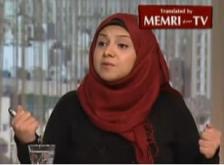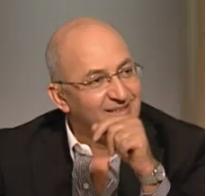How Asmaa Mahfouz Ignited Egypt & Became History In The Making
 Update December 17, 2011: the situation heats up yet again in Egypt. Here's how it all started..
Update December 17, 2011: the situation heats up yet again in Egypt. Here's how it all started..
Susan notes February 6, 2011: 26-year-old Egyptian activist and prolific vlogger Asmaa Mafhouz was one of the main instigators of the Egyptian part of the Arab Spring. This is her account of what led up to the events of January 25, 2010, and beyond. Watch the vlog that set the nation on fire here.
 The seasoned TV interviewer barely contains a mix of astonishment, amusement, and incredulity.
The seasoned TV interviewer barely contains a mix of astonishment, amusement, and incredulity.
His body language and questions say it all: he doesn't quite know what to make of this young hijab-clad woman who sits across from him explaining clearly, concisely and eloquently how she became the spark that ignited last week's revolutionary demonstrations in Cairo.
Twenty-six-year-old Asmaa Mahfouz, pen gripped firmly in one hand, says the seeds were sown a little over a year ago, when the April 6 Youth Movement, of which she is a member, organized protest activities to mark Egypt's first-ever Police Day, a nationwide holiday, on January 25, 2010.
"We remembered that in the past, the police suffered casualties, and fell in defense of the country," she says. "But in the current state of affairs is that the police are oppressing the people. Anyone who does anything suffers torture. People have died of police torture. Anybody who utters a word of truth in this country is oppressed by the police."
This year, the April 6 Movement (Facebook page here), planned to make demands to mark the second annual Police Day on January 25. They were twofold: 1) the dismissal of the interior minister, and to hold accountable all those responsible for country-wide security failures and for torture in the prisons, and 2) the dissolution of parliament.
 Rallying support for the cause was a challenge.
Rallying support for the cause was a challenge.
"Whenever he talked to the people and told them to express their views, they would say: 'Who can we talk to? We will be thrown in prison and tortured,'" Mahfouz recounts.
But the uprising in Tunisia proved to be a turning point, Egyptians began to be more hopeful about their collective ability to effect change. Sensing opportunity, the young people upped the volume, and the ante.
"When they saw what happened in Tunisia, people realized that there was an Arab people that revolted and demanded its rights." Mahfouz says. "Following these events, we began to tell people that we must take action, that we must revolt, and demand our rights."
Possibly triggered by the self-immolation of a young Tunisian man, and the resulting unrest, several Egyptians followed suit and set themselves alight. When officials did nothing but accuse the fiery protesters of mental illness, Mahfouz says the "people's blood began to boil."
The April 6 movement added a third demand to their January 25 slate: "A life of liberty and human dignity."
"The number of people setting fire to themselves gradually rose," Mahfouz says. "And in response, people began to say, on the streets and in Facebook: 'How come nobody's doing anything? Why aren't you taking action? Everybody says that something must be done, but the streets are empty.'"
Incensed, Mahfouz decided not to wait until January 25 to take action. A week before the planned protest, she posted her intention on Facebook and made her way alone to Tahrir Square, despite friends' pleas to wait.
"There were lots of messages (on Facebook) saying: “wait until January 25.” I said: “there's no reason to wait for the 25th. I went to Tahrir Square and raised a sign. Three guys from the political movement joined me. My sign read: "Four Egyptians have died from humiliation and poverty."
“I began to shout at the top of my lungs intact rear square:
"Egyptians, four people set themselves on fire at of humiliation and poverty. Egyptians, four people set fire to themselves because they were afraid of the security agencies, not of the fire.
"Four people set fire to themselves in order to tell you to awaken – we are setting ourselves on fire so that you will take action.
"Four people set themselves on fire in order to say to the regime: wake up, we are fed up. We are setting ourselves on fire in order to convey a message."
“Then I began to talk about 30 years of corruption…”
The police corralled the small group of protestors into a nearby building, they asked why Mahfouz hadn’t bothered to inform them of her demonstration.
Her reply?
"What are you talking about?" she said. "Four people set themselves on fire, and you are asking why we didn't announce the demonstration? You should be asking yourselves why they set themselves on fire. Because of the poverty and the corruption. One of them couldn't feed his daughter. Yet you still continue the oppression."
“I am not going to remain silent. If you want to set me on fire – go ahead. I am not budging from Tahrir Square.”
As it turns out, she did budge. At least on that day. And she went on to make a series of vlogs that set a whole nation on fire.
The rest, as they say, is history… in the making.